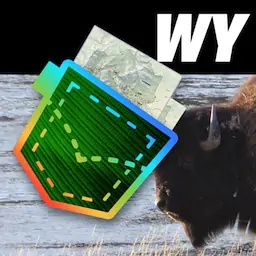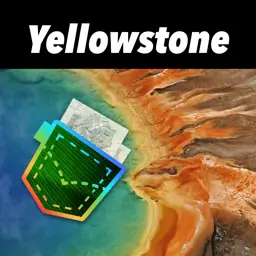"Grand Teton, Moose Entrance" by U.S. National Park Service , public domain
MountaineeringActivities |
Mountaineering brochure for Grand Teton National Park (NP) in Wyoming. Published by the National Park Service (NPS).
featured in
| National Parks Pocket Maps |  | |
| Idaho Pocket Maps |  | |
| Wyoming Pocket Maps |  | |
| Yellowstone Pocket Maps |  |
Grand Teton
National Park Service
U.S. Department of the Interior
Grand Teton National Park
John D. Rockefeller, Jr.
Memorial Parkway
Mountaineering
General Information
The Teton Range offers some of the most
accessible and diverse climbing in the country.
The wide array of rock, snow and ice, and mixed
routes range from easy outings to very difficult
undertakings.
There are many inherent risks and hazards
associated with all forms of climbing and
mountain travel. Risks include: lightning, rockfall,
avalanches, crevasses, and extreme weather
Mountain Weather
Weather conditions are usually best from
mid-July through August, although afternoon
thundershowers are common. In the high country,
late August usually sees at least one period of
inclement weather including snowfall. After
mid-August, major storms can occur anytime
producing snow and ice on most routes.
Winter weather is usually severe with heavy
snowfall, high winds, and extremely cold
conditions (even during the summer months). A
fall on steep snow and failing to self-arrest with an
ice axe is the number one cause of accidents and
deaths.
Please be responsible for your actions.
Competent technique, experience, safety
equipment, physical fitness and good judgment
are essential to preventing or minimizing the
chances of an accident.
temperatures. During winter and early spring,
avalanche danger is frequently high. Winter
mountaineering trips should be undertaken only
by well-equipped, self-sufficient parties with
considerable experience.
Spring and early summer are characterized by
rain, some snow and sub-freezing temperatures.
During these months, rockfall and wet-snow
avalanche activity are a common.
Backcountry Permits
Accommodations
Equipment
Registration is not required for climbing,
mountaineering or day hiking. A
backcountry permit is required for all
overnight use (fee). During summer, all
permits involving climbing are issued by
the Jenny Lake Ranger Station.
The American Alpine Club Climbers'
Ranch, a park concession, provides
low-cost accommodations for climbers.
For information: americanalpineclub.
org/grand-teton-climbers-ranch. Park
campgrounds may be used as base camps,
although each campground has a limit-of
stay. All overnight stays in the backcountry
require a permit.
Conventional mountaineering equipment
is adequate for climbing in the Teton
Range in summer. An ice axe and expertise
in its use is the single most important
technique needed for early season
climbs. Climbing helmets are strongly
recommended for all climbs. Climbing
equipment and backpacking supplies may
be purchased in the area, and a limited
selection of equipment may be rented.
The park does not check to see that you
return safely. Provide someone with
your itinerary, and have them notify
authorities if you are overdue.
Rescue Guidelines
Self-Rescue
In the event of an accident or other issue, be
self reliant—focus on other party members and
your own efforts! Enlist the aid of other climbers
in the area. Do not depend on the park rescue
team. In the event of a known injury, the rescue
team will make efforts to help you. Keep in mind,
however, that the decision if, when or how to
initiate a search or rescue is left to the discretion of
Grand Teton National Park. Many factors, such as
weather, daylight, and hazards to the rescue team
may delay or postpone any park rescue effort.
Grand Teton National Park Rescue Team
The park’s search and rescue team is fully staffed
only during the summer months. If self-rescue is
impossible, notify the park as quickly as possible.
What to Do When an Accident Occurs
Do not leave an accident victim alone unless
absolutely necessary. If it is necessary to leave an
injured person, provide first aid, secure the person
to prevent further injury, leave food, water and
warm clothes before going for help. Be able to
relay the following information: name, age, weight
of victim(s), exact location of the accident, nature
of the injuries, time of the accident, equipment
at the scene, number of persons remaining at the
scene and plan of action.
Search & Rescue Funding
All climbers should be aware that search and
rescue operations are funded from the park
budget. Large expenditures may result in
reduction of other services. Please send tax
deductible donations to help support the rescue
team: Mountain Rescue Fund, Grand Teton
National Park, P.O. Box 170, Moose, WY 83012.
References
Several guidebooks are currently available for the Teton Range
include Best Climbs: Grand Teton National Park by Richard
Rossiter and A Climber's Guide to the Teton Range by Leigh
N. Ortenburger and Reynold G. Jackson. Topographic
trail maps are also available. These publications may be
purchased at park visitor center bookstores or by mail from
the Grand Teton Association, Grand Teton National Park,
P.O. Box 170, Moose, WY 83012, or on the web: www.
grandtetonpark.org .
Guide Services
Two mountaineering guide services
operate in Grand Teton National Park:
• Exum Mountain Guides, Inc.
exumguides.com
P.O. Box 8759
Jackson, WY 83002
307-733-2297
• Jackson Hole Mountain Guides
jhmg.com
P.O. Box 7477
Jackson, WY 83001
307-733-4979
Climbing Ethics
CLIMBING INFORMATION
The Jenny Lake Ranger Station is
the center for climbing information
from June to early-September.
Climbing rangers on duty provide
current information on the nature
and condition of climbing routes,
equipment and experience
considerations, and time factors.
Guidebooks, maps, and
photographs of various
p eaks an d routes are
available to assist in
planning climbs.
Renew your commitment to leave no trace!
We are appealing to all climbers to accept personal
responsibility for the care of fragile resources.
Toward this goal, please adhere to the following
code of ethics for minimum impact climbing:
• Use existing access trails to approach climbs.
Short-cutting trails causes plant damage and
erosion and is prohibited.
• During approach and descent where there are no
trails, carefully choose routes to avoid the heavy
impact of human feet. Step on rocks and nonvegetated surfaces where possible.
• Know and respect environmentally sensitive
areas. Be considerate of wildlife and other users.
Keep a respectful distance from all animals to
avoid disturbing their natural routines.
• Leave the rock and its environs in its natural
condition. Avoid placing permanent protection.
Motorized drills are prohibited.
• Plan your trip. Know and abide by all park
regulations.
• Accept responsibility for yourself and others.
"Leave No Trace" depends more on attitude and
awareness than on regulations.
• Pack out all litter. Use toilets where available or
bury human waste 200' from water and high use
areas. Double bag toilet paper in ziplock bags
and carry it out or use natural options such as
stones, sticks or snow.
Only by following a minimum impact climbing
ethic can outstanding natural features be
protected for future generations of climbers. The
future of climbing is in your hands!
Rev. 07/2017




